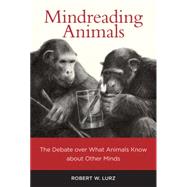
| Preface | p. xi |
| Acknowledgments | p. xvii |
| Mindreading in Animals: It Importance and History | p. 1 |
| Why the Question of Animal Mindreading Matters | p. 3 |
| A Brief History of the Animal Mindreading Debate | p. 7 |
| Conclusion | p. 18 |
| The Logical Problem in Animal Mindreading Research | p. 21 |
| Mindreading in Animal Social Cognition Research: The Issues | p. 21 |
| The Logical Problem | p. 25 |
| Current Protocols to Test for Cognitive State Attribution in Animals | p. 32 |
| Hare and ColleaguesÆ Competitive Paradigm Experiment | p. 32 |
| A Complementary Behavior-Reading Hypothesis: Direct Line of Gaze | p. 34 |
| Are Complementary Behavior-Reading Hypothesis Necessarily Ad Hoc? | p. 38 |
| The Issue of Simplicity | p. 42 |
| Knowledge/Ignorance Attribution in Primates | p. 49 |
| Those Amazing Scrub Jays | p. 54 |
| Remarks on Goal-Directed/Intentional-Action Attribution in Animals | p. 61 |
| Conclusion | p. 66 |
| Solving the Logical Problem for Perceptual State Attribution | p. 67 |
| The Case against Animal Mindreading of Any Kind | p. 67 |
| A General Framework for Solving the Logical Problem | p. 76 |
| The Appearance-Reality Mindreading (ARM) Theory | p. 83 |
| How Animals Might Attributes States of Perceptual Appearing | p. 88 |
| Experimental Protocols That Can Solve the Logical Problem | p. 96 |
| Visual Perspective Taking with Chimpanzees using Transparent Colored Barriers | p. 96 |
| Visual Perspective Taking with Chimpanzees using Size-Distorting Barriers | p. 101 |
| Visual Perspective Taking with Ravens using Deceptive Amodal Completion Stimuli | p. 106 |
| Visual Perspective Taking with Chimpanzees using Deceptive Amodal Completion Stimuli | p. 116 |
| Visual Perspective Taking with Dogs using Deceptive Amodal Completion Stimuli | p. 121 |
| Conclusion | p. 129 |
| Solving the Logical Problem for Belief Attribution | p. 131 |
| DavidsonÆs Argument against Belief Attribution in Animals | p. 131 |
| BermúdezÆs Argument against Belief Attribution in Animals | p. 138 |
| The Empirical Studies | p. 144 |
| From Perceptual Appearing Attribution to Belief Attribution | p. 157 |
| A Simple Appearance-Reality Screening Test | p. 164 |
| Revisability Belief-Attribution Protocol No. 1 | p. 170 |
| Revisability Belief-Attribution Protocol No. 2 | p. 176 |
| Representation of Abstract Relations by Primates | p. 184 |
| Abstract Belief-Attribution Protocol | p. 186 |
| Conclusion | p. 193 |
| Epilogue | p. 195 |
| Notes | p. 197 |
| References | p. 219 |
| Index | p. 243 |
| Table of Contents provided by Ingram. All Rights Reserved. |
The New copy of this book will include any supplemental materials advertised. Please check the title of the book to determine if it should include any access cards, study guides, lab manuals, CDs, etc.
The Used, Rental and eBook copies of this book are not guaranteed to include any supplemental materials. Typically, only the book itself is included. This is true even if the title states it includes any access cards, study guides, lab manuals, CDs, etc.